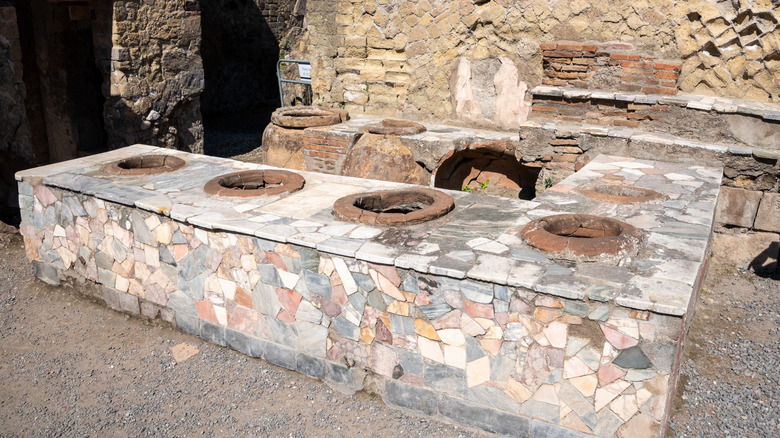Here's How Ancient Romans Seasoned The World's First Hamburgers
The United States has taken a lot of ideas from Ancient Rome. The authors of the Constitution famously based many of their best ideas on the framework of Rome's justice system and representative democracy, the legacy of Roman architecture can be seen in the pillars of the U.S. Capitol, and a great portion of our language can be traced to Ancient Rome. You probably learned all of that in school, but did you know that without the Romans, we wouldn't have McDonald's? That's right, the hamburger, arguably the most American of foods, is just another idea we stole from the Romans.
Hamburger history is a difficult thing to trace because there are so many legends surrounding the dish. In reality, the dish slowly evolved over centuries to reach its modern form. It's hard to pinpoint an exact origin for burgers, but the closest lead comes from an Ancient Roman cookbook called "Apicius de re Coquinaria." Published in the fourth century, it contains over 400 recipes, but for burger scholars, there's a particular one that stands out. It's a dish called Isicia Omentata, composed of minced meat blended with nuts, berries, spices, and wine. It's not quite a burger and not quite a meatball, but it may hold the secret to the history of both dishes.
Isicia Omentata was a forerunner of burgers and meatballs
The recipe for Isicia Omentata preserved in "Apicius de re Coquinaria" calls for lean minced meat seasoned with pepper, myrtle berry, wine, and pine nuts. It also recommends adding an optional touch of garum, the ancient fish sauce Romans put on everything. There's one other ingredient that is particularly notable, and that's bread. Bread is not something you would expect to see in hamburger mix, but breadcrumbs are almost always used in meatball recipes to help soak up moisture and keep the meat juicy (or you can swap oats in place of breadcrumbs in meatballs). In Isicia Omentata, we find a common ancestor of both burgers and meatballs, although it was served in a very different manner than either.
One of the defining features of Isicia Omentata is that each meatball is wrapped in caul fat — a weblike membrane that surrounds an animal's internal organs, which has long been used as a casing for sausages and other ground meat dishes. This membrane is technically called the omentum, which is where the word "Omentata" comes from. The word "Isicia" refers to foods made from minced meat, and "Apicius de re Coquinaria" includes many examples beyond Isicia Omentata, with versions made from pork, pheasant, lobster, and more. Out of all of these, Isicia Omentata appears to have the closest relationship to the modern hamburger, and it's not the only way that the Ancient Romans shaped this dish.
The Romans were pioneers of fast food
It took centuries for the ancient dish of Isicia Omentata to evolve into today's hamburgers. It was only after ground beef was introduced to the U.S. via German immigrants (which is why ground meat is called hamburger in the first place), that it became common to serve ground meat on buns instead of a plate. But that doesn't mean the Romans were eating everything in a formal setting. Far from it, in fact. The Ancient Romans are widely credited with pioneering the concept of fast food, which is how most people get their burgers today. It's yet another way the old empire has shaped America's favorite dish.
The Ancient Roman equivalent of modern fast food joints were known as "thermopolia". They were small stalls where foods were kept in clay jars that functioned like chafing dishes. Thermopolia are mentioned in numerous Roman texts, but more importantly, archaeologists have uncovered the remains of hundreds of these food stalls in the remnants of cities like Pompeii and Herculaneum. Some had counters for customers, but others were take-out only. Like the fast food burgers of today, the food at thermopolia provided affordable sustenance to the working class, many of whom did not have kitchens in their homes.


